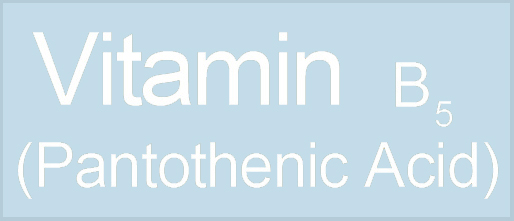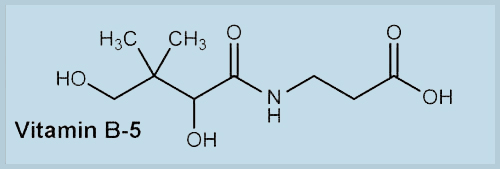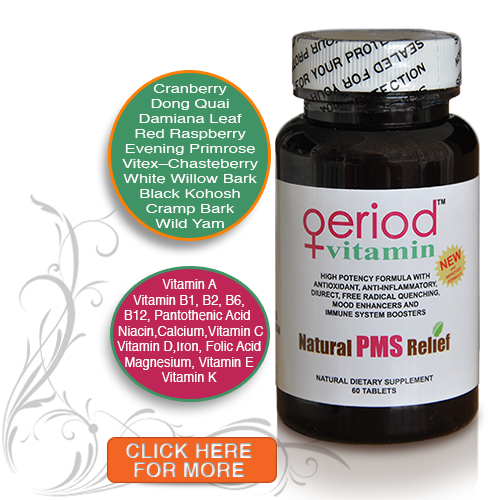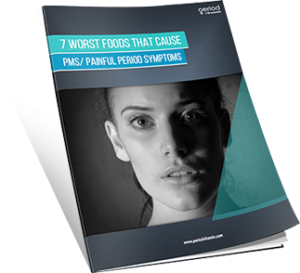 That might be a question many women are asking upon seeing the title of this article. Pantothenic acid is actually Vitamin B5 but it is a vitamin many people have not heard of regardless of what you title it.
That might be a question many women are asking upon seeing the title of this article. Pantothenic acid is actually Vitamin B5 but it is a vitamin many people have not heard of regardless of what you title it.
A few more people might say they are familiar with Vitamin B5 than with Pantothenic Acid, but the truth is that B5 is one of the lesser known of the B complex vitamins.
So how does Pantothenic Acid (Vitamin B5) help with pms? What are the pms symptoms that Pantothenic Acid (Vitamin B5) can affect?
Let’s take a look at Vitamin B5 (Pantothenic Acid) and what it is and how it functions.
What happens if one has a Vitamin B5 (Pantothenic Acid) deficiency and if you are going to take Vitamin B5 (Pantothenic Acid) what is the best dosage?
Where can you find natural versions of Pantothenic Acid (Vitamin B5) in foods or teas?
In 1919 Roger J. Williams discovered the water soluble vitamin now known as Pantothenic Acid or Vitamin B5. It was also discovered that this vitamin seems to be present in just about every human food source. However Pantothenic Acid (Vitamin B5) is present in abundance in foods such as yogurt, cereals, avocado, legumes, royal jelly, meat and eggs. Vitamin B5 (Pantothenic Acid) plays a major role in a wide variety of the body’s functions and if you are deficient in this vitamin, it can cause you a variety of problems. Pantothenic Acid (Vitamin B5) assists the body with the metabolism of the foods we eat. That is why it can be effective against nausea, vomiting, and food cravings.
Let’s look at how Vitamin B5 (Pantothenic Acid) or a deficiency of such, affects the symptoms and treatment of the maladies associated with pms. Since this vitamin is water soluble, it is not stored in the body for any length of time, but rather passes through quickly in the urine or in human sweat. Irritability, fatigue and apathy are associated with a Vitamin B5 (Pantothenic Acid) deficiency. Neurological symptoms of a deficiency include numbness and muscle cramps among others. Other symptoms that can occur with a deficiency might include abdominal cramps, nausea, malaise, vomiting, restlessness, and sleep issues such as insomnia.
 You can see immediately that some of the issues caused by a deficiency of Vitamin B5 (Pantothenic Acid) are the same as some symptoms of pms. This would include irritability, fatigue, cramping, nausea, vomiting, and insomnia. These symptoms will be many times worse if you don’t have enough Pantothenic Acid (Vitamin B5) in your body and remember that this vitamin is water soluble. If you take it today it will not still be in your system tomorrow. You have to take it consistently to see any benefit from it. It is also very unlikely that you would experience any Vitamin B5 (Pantothenic Acid) toxicity for this very reason. It does not accumulate in the body, rather it passes through.
You can see immediately that some of the issues caused by a deficiency of Vitamin B5 (Pantothenic Acid) are the same as some symptoms of pms. This would include irritability, fatigue, cramping, nausea, vomiting, and insomnia. These symptoms will be many times worse if you don’t have enough Pantothenic Acid (Vitamin B5) in your body and remember that this vitamin is water soluble. If you take it today it will not still be in your system tomorrow. You have to take it consistently to see any benefit from it. It is also very unlikely that you would experience any Vitamin B5 (Pantothenic Acid) toxicity for this very reason. It does not accumulate in the body, rather it passes through.
Another symptom that occurs during pms that might be cured or treated with Vitamin B5 (Pantothenic Acid) is acne. Many women suffer with a reoccurrence of acne every month because of the hormonal imbalance during their menstrual cycle. In the Follicular and Luteal phases of the menstrual cycle there is a release of an overabundance of estrogen (Follicular phase) and progesterone (Luteal phase) that causes this imbalance and potentially causes acne. In the past 30 years studies have shown that Vitamin B5 (Pantothenic Acid) can cure acne.
There are several stages of the menstrual cycle that includes the Follicular and Luteal stages. These are as follows: The premenstrual stage when many pms symptoms appear including headaches, cramping and light sensitivity. The next two stages are the Follicular and the Luteal stages in which you have the production of a severe hormonal imbalance that is the basic cause of almost all pms symptoms. You get cramping and bloat more often in the Follicular stage due to the overabundance of estrogen and in the Luteal stage with the counter activity of progesterone. This is followed by the bleeding stage or the “period”. There can be irregular bleeding and heavy bleeding at this stage. The last stage is the postmenstrual stage and for most women all the pms symptoms die down. There are however some women who continue to experience pms associated symptoms throughout this stage. Acne can be present in any and all of these stages and Vitamin B5 (Pantothenic Acid) can be used to counter act this.
“According to a study published in 1995 by Dr. Lit-Hung Leung, [35] high doses of vitamin B5 resolved acne and decreased pore size. Dr. Leung also proposed a mechanism, stating that CoA regulates both hormones and fatty acids, and without sufficient quantities of pantothenic acid, CoA will preferentially produce androgens. This causes fatty acids to build up and be excreted through sebaceous glands, causing acne. Leung’s study gave 45 Asian males and 55 Asian females varying doses of 10–20g of pantothenic acid (100000% of the US Daily Value), 80% orally and 20% through topical cream. Leung noted improvement of acne within one week to one month of the start of the treatment.”
(http://en.wikipedia.org/wiki/Pantothenate)
Vitamin B5 (Pantothenic Acid) is also a vital component in boosting the human body’s human system. This is helpful to the reduction of pms associated symptoms, because a weak immune system only exasperates those symptoms. The last thing a woman dealing with any of the many pms symptoms wants to deal with in addition to that is another illness even if it is as simple as a cold. So you want to make sure your immune system is strong.
It is also true that Vitamin B5 (Pantothenic Acid) is proposed as a treatment for pms related headaches, stress and tension. It is effective in treating pms related abdominal cramps because it is overall effective against all kinds of muscle cramping. So when the excessive bloating of pms pushes on the pelvic area and causes abdominal cramps the anti-cramping properties of Vitamin B5 (Pantothenic Acid) can be a major asset.
Because there is naturally a large amount of Vitamin B5 (Pantothenic Acid) in the brain, if there is a deficiency of this vitamin it can cause depression, mood swings, cognitive issues and sleep issues such as fatigue and insomnia. Again these are all also symptoms of pms and so an increase in Vitamin B5 (Pantothenic Acid) will help to reduce these symptoms as well. Pantothenic Acid (Vitamin B5) is an excellent treatment. It is however better off used in conjunction with the rest of the vitamins in the B complex as well as other pms herbs and minerals.
So what is the best way to get the Vitamin B5 (Pantothenic Acid) into your system? Should you just take a B complex supplement?
That would be better than taking the B5 by itself, but it would not be the best way to counter the symptoms of pms. Taking a supplement that includes the B complex plus other vitamins, minerals and herb that are specifically designed to counter act pms symptoms would be the best course of action.
Period Vitamin is just such a supplement.
 Period Vitamin contains a wide variety of vitamins, minerals and herbs including the B vitamins. In addition to Vitamin B5 (Pantothenic Acid), Period Vitamin has these B vitamins. Vitamin B1 helps with any irregular period blood flows. Vitamin B6 helps to relieve swelling and cramping. Niacin is a B vitamin that helps to regulate the pms symptoms of vomiting and nausea, depression and irritability, fatigue and sleep disturbances, stress and loss of appetite. Folic Acid helps to regulate the menstrual flow.
Period Vitamin contains a wide variety of vitamins, minerals and herbs including the B vitamins. In addition to Vitamin B5 (Pantothenic Acid), Period Vitamin has these B vitamins. Vitamin B1 helps with any irregular period blood flows. Vitamin B6 helps to relieve swelling and cramping. Niacin is a B vitamin that helps to regulate the pms symptoms of vomiting and nausea, depression and irritability, fatigue and sleep disturbances, stress and loss of appetite. Folic Acid helps to regulate the menstrual flow.
In addition to these B complex vitamins, Period Vitamin also contains a series of other vitamins. Vitamin K assists in the clotting of blood. Vitamin C helps the body absorb some of the most important herbs for pms including Evening Primrose Oil (EPO) as well as calcium. It helps with the absorption of iron and the control of the amount of bleeding during your period. This is just a sampling of what is contained in Period Vitamin. There are many other herbs and minerals as well that help treat pms symptoms in Period Vitamin. No matter where you get your Vitamin B5 (Pantothenic Acid) your menstrual cycle will be a little easier to manage if you take it in some form.



